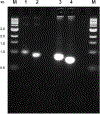Universal Southern blot protocol with cold or radioactive probes for the validation of alleles obtained by homologous recombination
- PMID: 32599056
- PMCID: PMC10790599
- DOI: 10.1016/j.ymeth.2020.06.011
Universal Southern blot protocol with cold or radioactive probes for the validation of alleles obtained by homologous recombination
Abstract
The widespread availability of recombineered vectors and gene targeted embryonic stem cells from large-scale repositories facilitates the generation of mouse models for functional genetic studies. Southern blotting validates the structure of these targeted alleles produced by homologous recombination, as well as indicating any additional integrations of the vector into the genome. Traditionally this technique employs radioactively-labelled probes; however, there are many laboratories that are restricted in their use of radioactivity. Here, we present a widely applicable protocol for Southern blot analysis using cold probes and alternative procedures employing radioactive probes. Furthermore, the probes are designed to recognise standardised regions of gene-targeting cassettes and so represent universally applicable reagents for assessing allelic integrity.
Keywords: Homologous recombination; Mouse; Southern blot; Targeting; Validation.
Copyright © 2020 The Authors. Published by Elsevier Inc. All rights reserved.
Figures




Similar articles
-
Generation of knockout alleles by RFLP based BAC targeting of polymorphic embryonic stem cells.Methods Mol Biol. 2015;1227:143-80. doi: 10.1007/978-1-4939-1652-8_7. Methods Mol Biol. 2015. PMID: 25239745
-
Gene Targeted Mice with Conditional Knock-In (-Out) of NMDAR Mutations.Methods Mol Biol. 2017;1677:201-230. doi: 10.1007/978-1-4939-7321-7_11. Methods Mol Biol. 2017. PMID: 28986875
-
Identification of Homologous Recombination Events in Mouse Embryonic Stem Cells Using Southern Blotting and Polymerase Chain Reaction.J Vis Exp. 2018 Nov 20;(141):10.3791/58467. doi: 10.3791/58467. J Vis Exp. 2018. PMID: 30531726 Free PMC article.
-
Targeting embryonic stem cells.Methods Mol Biol. 2009;561:185-97. doi: 10.1007/978-1-60327-019-9_12. Methods Mol Biol. 2009. PMID: 19504072
-
A dual color Southern blot to visualize two genomes or genic regions simultaneously.J Virol Methods. 2014 Mar;198:64-8. doi: 10.1016/j.jviromet.2013.12.019. Epub 2014 Jan 2. J Virol Methods. 2014. PMID: 24389128 Free PMC article. Review.
Cited by
-
ATRX restricts Human Cytomegalovirus (HCMV) viral DNA replication through heterochromatinization and minimizes unpackaged viral genomes.PLoS Pathog. 2024 Sep 5;20(9):e1012516. doi: 10.1371/journal.ppat.1012516. eCollection 2024 Sep. PLoS Pathog. 2024. PMID: 39236084 Free PMC article.
-
Long-read sequencing for fast and robust identification of correct genome-edited alleles: PCR-based and Cas9 capture methods.PLoS Genet. 2024 Mar 8;20(3):e1011187. doi: 10.1371/journal.pgen.1011187. eCollection 2024 Mar. PLoS Genet. 2024. PMID: 38457464 Free PMC article.
-
Reducing mitochondrial ribosomal gene expression does not alter metabolic health or lifespan in mice.Sci Rep. 2023 May 24;13(1):8391. doi: 10.1038/s41598-023-35196-3. Sci Rep. 2023. PMID: 37225705 Free PMC article.
-
Importing genetically altered animals: ensuring quality.Mamm Genome. 2022 Mar;33(1):100-107. doi: 10.1007/s00335-021-09908-x. Epub 2021 Sep 18. Mamm Genome. 2022. PMID: 34536110 Free PMC article. Review.
-
3R measures in facilities for the production of genetically modified rodents.Lab Anim (NY). 2022 Jun;51(6):162-177. doi: 10.1038/s41684-022-00978-1. Epub 2022 May 31. Lab Anim (NY). 2022. PMID: 35641635 Review.
References
-
- Skarnes WC, Rosen B, West AP, Koutsourakis M, Bushell W, Iyer V, Mujica AO, Thomas M, Harrow J, Cox T, Jackson D, Severin J, Biggs P, Fu J, Nefedov M, de Jong PJ, Stewart AF, Bradley A, A conditional knockout resource for the genome-wide study of mouse gene function, Nature 474 (2011) 337–342, 10.1038/nature10163. - DOI - PMC - PubMed
-
- Birling M-C, Yoshiki A, Adams DJ, Ayabe S, Beaudet AL, Bottomley J, Bradley A, Brown SD, Bürger A, Bushell W, Chiani F, Chin H-JG, Christou S, Codner GF, DeMayo FJ, Dickinson ME, Doe B, Donahue LR, Fray MD, Gambadoro A, Gao X, Gertsenstein M, Gomez-Segura A, Goodwin LO, Heaney JD, Hérault Y, de Angelis MH, Jiang S-T, Justice MJ, Kasparek P, King RE, Kühn R, Lee H, Lee YJ, Liu Z, Kent Lloyd KC, Lorenzo I, Mallon AM, McKerlie C, Meehan TF, Newman S, Nutter LM, Oh GT, Pavlovic G, Ramirez-Solis R, Rosen B, Ryder EJ, Santos LA, Schick J, Seavitt JR, Sedlacek R, Seisenberger C, Seong JK, Skarnes WC, Sorg T, Steel KP, Tamura M, Tocchini-Valentini GP, Leo Wang C-K, Wardle-Jones H, Wattenhofer-Donzé M, Wells S, Willis BJ, Wood JA, Wurst W, Xu Y, Teboul L, Murray SA, A resource of targeted mutant mouse lines for 5,061 genes, BioRxiv (2019) 844092, 10.1101/844092. - DOI - PMC - PubMed
Publication types
MeSH terms
Grants and funding
LinkOut - more resources
Full Text Sources
Other Literature Sources

